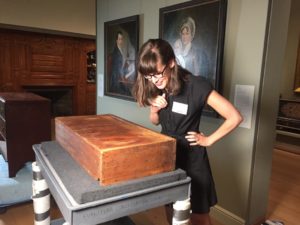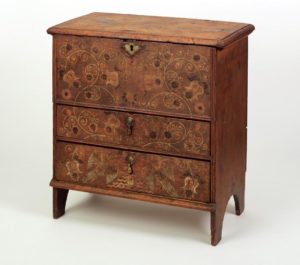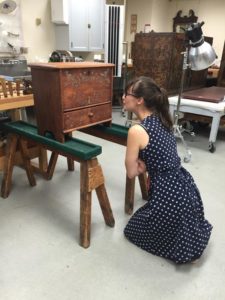REVISITING TAUNTON: THE CHESTS OF ROBERT CROSMAN
EMERGING SCHOLARS > SUMMER RESEARCH GRANTS
By EMELIE GEVALT,
Winterthur Program in American Material Culture, University of Delaware
Generous funding from the Decorative Arts Trust facilitated essential foundational research on my Winterthur thesis this past summer, as I studied the painted chests of Taunton, MA, attributed to Robert Crosman. My work took me to cities across the Northeast as well as the Midwest, where the early-to-mid-18th-century chests are found in museum collections, ranging from the Art Institute of Chicago to the Old Colony History Museum in Taunton itself.
With the gracious help of numerous curators and museum staff, I examined firsthand almost all the Crosman chests currently held in public collections. Along the way, I drew diagrams, took endless photographs, and compiled a chart of comparative data on points of construction, decoration, and object history. This key primary-source research forms the basis of my thesis, against which I posed questions about authorship, ownership, and the creative process.
I first became captivated by Taunton chests during my furniture connoisseurship course at Winterthur, when I investigated an example acquired by Henry Francis du Pont. Although the chests are simply constructed, they are often intricately decorated, featuring tenderly expressive tree-of-life-type designs. The complexity of the decoration varies considerably from one piece to the next, ranging from roughly executed single trees to far more elaborate overlapping compositions of multiple birds, vines, berries, and blossoms.
These intriguing contrasts of decoration and construction inspire questions. Was Robert Crosman truly the sole maker of each of the chests attributed to him? Can we view the changing complexity of decoration as a gradual artistic progression, as one early scholar suggested, or is this idea an imposition of a 20th-century art historical conceit? What design sources inspired the maker(s), and how might they have been transmitted to a small Massachusetts town? Finally, how might the chests’ “rediscovery” by Americana collectors in the early 20th century have impacted our present-day interpretations of their painted designs?
The time is ripe for a reexamination of this subject. In 1933, Esther Stevens Fraser published an article in The Magazine Antiques on Taunton chests, forming the basis of scholarship on the group. She proposed Crosman as the maker on the basis of a single example initialed “Taunton, R.C., 1729.” Although scholars and curators have since addressed the chests in catalogue entries and other short studies, no comprehensive review of Fraser’s original findings has been published. In addition to exploring the questions posted above, a major component of my thesis is a catalogue documenting the chests to encourage further study.
The opportunity to examine multiple chests in person has laid essential groundwork for my project. I truly am grateful to the Decorative Arts Trust for helping to make my summer research trips possible.
By EMELIE GEVALT,
Winterthur Program in American Material Culture, University of Delaware
Generous funding from the Decorative Arts Trust facilitated essential foundational research on my Winterthur thesis this past summer, as I studied the painted chests of Taunton, MA, attributed to Robert Crosman. My work took me to cities across the Northeast as well as the Midwest, where the early-to-mid-18th-century chests are found in museum collections, ranging from the Art Institute of Chicago to the Old Colony History Museum in Taunton itself.
With the gracious help of numerous curators and museum staff, I examined firsthand almost all the Crosman chests currently held in public collections. Along the way, I drew diagrams, took endless photographs, and compiled a chart of comparative data on points of construction, decoration, and object history. This key primary-source research forms the basis of my thesis, against which I posed questions about authorship, ownership, and the creative process.
I first became captivated by Taunton chests during my furniture connoisseurship course at Winterthur, when I investigated an example acquired by Henry Francis du Pont. Although the chests are simply constructed, they are often intricately decorated, featuring tenderly expressive tree-of-life-type designs. The complexity of the decoration varies considerably from one piece to the next, ranging from roughly executed single trees to far more elaborate overlapping compositions of multiple birds, vines, berries, and blossoms.
These intriguing contrasts of decoration and construction inspire questions. Was Robert Crosman truly the sole maker of each of the chests attributed to him? Can we view the changing complexity of decoration as a gradual artistic progression, as one early scholar suggested, or is this idea an imposition of a 20th-century art historical conceit? What design sources inspired the maker(s), and how might they have been transmitted to a small Massachusetts town? Finally, how might the chests’ “rediscovery” by Americana collectors in the early 20th century have impacted our present-day interpretations of their painted designs?
The time is ripe for a reexamination of this subject. In 1933, Esther Stevens Fraser published an article in The Magazine Antiques on Taunton chests, forming the basis of scholarship on the group. She proposed Crosman as the maker on the basis of a single example initialed “Taunton, R.C., 1729.” Although scholars and curators have since addressed the chests in catalogue entries and other short studies, no comprehensive review of Fraser’s original findings has been published. In addition to exploring the questions posted above, a major component of my thesis is a catalogue documenting the chests to encourage further study.
The opportunity to examine multiple chests in person has laid essential groundwork for my project. I truly am grateful to the Decorative Arts Trust for helping to make my summer research trips possible.



